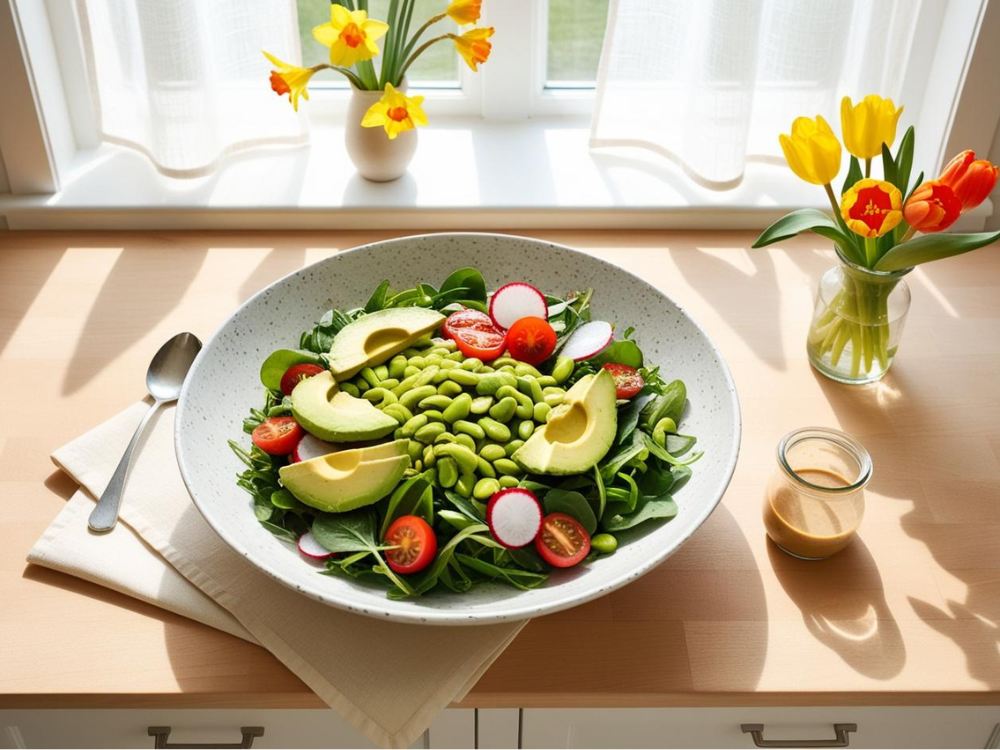Thai Coconut Curry Soup with Shrimp
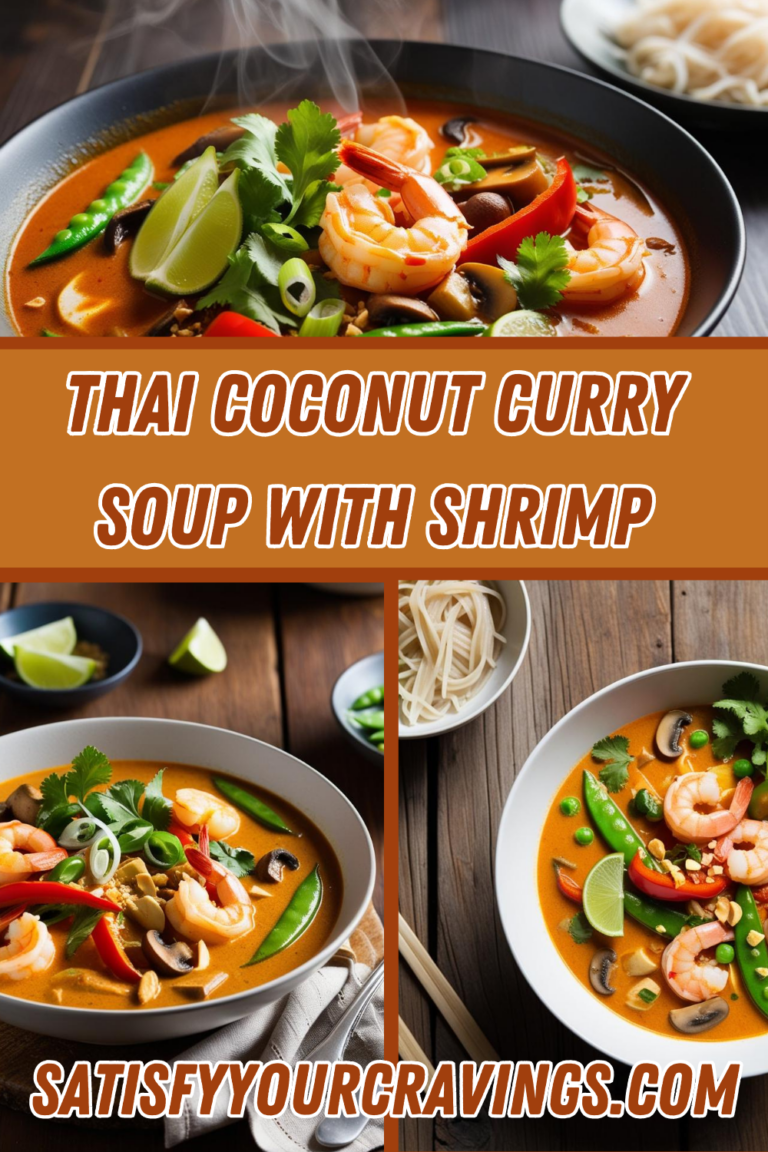
A Quick, Flavor-Packed Dinner You'll Love
Are you ready to elevate your dinner game with a dish that’s equal parts comforting and exotic? This Thai Coconut Curry Soup with Shrimp is the ultimate bowl of goodness. With its creamy coconut milk base, bold red curry flavor, and perfectly cooked shrimp, this recipe is a delicious escape to the vibrant streets of Thailand—no passport required. Whether you’re a curry lover or new to Thai cuisine, this soup delivers just the right balance of spice, tang, and creaminess that’ll have you coming back for seconds.
What makes this dish even better? It’s quick, easy, and made in just one pot, making it perfect for weeknights or when you’re short on time. Packed with fresh veggies like snap peas, red bell peppers, and mushrooms, it’s as nourishing as it is flavorful. Pair it with rice noodles for a hearty meal or enjoy it on its own for a lighter option. Trust us, this is one recipe your taste buds—and your family—will thank you for!
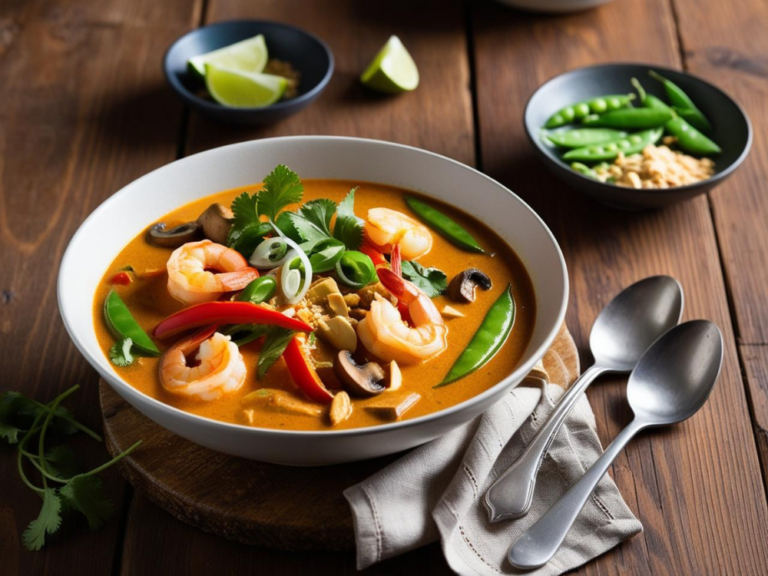
Health Benefits of Thai Coconut Curry Soup with Shrimp
Did you know that Thai Coconut Curry Soup with Shrimp isn’t just delicious—it’s also incredibly nutritious? This flavorful dish is packed with ingredients that provide a variety of health benefits, making it the perfect meal when you want something comforting and good for you. Let’s break down why this soup is more than just a tasty dinner idea and how it can be a wholesome addition to your diet.
1. Shrimp: Lean Protein and Vital Nutrients
One of the key ingredients in Thai Coconut Curry Soup with Shrimp is, of course, the shrimp. Not only is shrimp a low-calorie source of high-quality protein, but it’s also packed with essential nutrients like:
- Selenium: A powerful antioxidant that supports your immune system and protects your cells.
- Vitamin B12: Boosts energy and supports brain health.
- Iodine: Helps regulate your thyroid, which is key to maintaining a healthy metabolism.
Shrimp is also low in fat and carbs, making it a great option for a lighter, more nutritious soup that doesn’t skimp on flavor.
2. Coconut Milk: Creamy and Nutrient-Rich
The rich, creamy base of this Thai Coconut Curry Soup with Shrimp comes from coconut milk. While it adds that indulgent texture, it also provides:
- Healthy Fats: These medium-chain fatty acids are easily digested and can provide lasting energy.
- Lauric Acid: Known for its antibacterial and antiviral properties, helping to support a healthy immune system.
- Dairy-Free Goodness: Coconut milk is perfect for those who are lactose-intolerant or avoiding dairy products.
Plus, coconut milk helps balance the bold flavors of the curry while adding a touch of natural sweetness.
3. Red Curry Paste: A Flavorful Health Boost
Red curry paste is the heart of this dish, and it’s more than just a flavor enhancer. This blend of spices, herbs, and chilies is packed with health benefits:
- Capsaicin (from chilies): Boosts metabolism and promotes better circulation.
- Turmeric: A natural anti-inflammatory powerhouse that supports joint and overall health.
- Garlic and Shallots: Antioxidant-rich ingredients that help strengthen your immune system.
This combination of bold flavors and health benefits makes the curry paste an integral part of the soup.
4. Fresh Vegetables: A Colorful Nutritional Boost
What makes Thai Coconut Curry Soup with Shrimp truly shine is the variety of fresh vegetables it includes. Ingredients like red bell peppers, snap peas, and mushrooms add color, crunch, and an array of nutrients:
- Red Bell Peppers: Packed with vitamin C, which supports a strong immune system and promotes glowing skin.
- Snap Peas: High in fiber, vitamin K, and antioxidants to keep you feeling your best.
- Mushrooms: A great source of B vitamins and selenium, which are important for brain health and immune function.
These vibrant vegetables not only make the soup more delicious but also provide an impressive dose of vitamins and minerals in every bowl.
5. Lime Juice: Bright, Zesty, and Nutritious
A squeeze of lime juice may seem like a small addition, but it plays a big role in balancing the flavors of the soup. Even better, lime juice is rich in vitamin C, an essential antioxidant that boosts immunity, supports healthy skin, and aids in iron absorption. It’s a simple ingredient that adds a burst of freshness while delivering key nutrients.
6. Balanced Nutrition in Every Bowl
Thai Coconut Curry Soup with Shrimp is more than just a meal—it’s a perfect example of a balanced dish. Here’s what you get in every serving:
- Protein: Shrimp provides the lean protein your body needs for energy and muscle repair.
- Healthy Fats: Coconut milk adds creaminess while offering good fats for sustained energy.
- Vitamins and Fiber: Fresh veggies provide essential nutrients to support your overall health.
Because it’s naturally dairy-free and gluten-free, this soup is a fantastic option for a wide range of dietary needs, and it can easily be adjusted to fit specific diets like keto or paleo.
7. Why It’s a Comfort Food You Can Feel Good About
While many comfort foods are heavy or packed with empty calories, Thai Coconut Curry Soup with Shrimp is the perfect blend of indulgence and nutrition. The creamy coconut milk, bold curry paste, and fresh, vibrant veggies create a dish that warms your soul while nourishing your body.
Why Readers Will Love It
Highlighting the health benefits of this Thai Coconut Curry Soup with Shrimp gives your readers even more reason to try it. Not only will they feel good about making a wholesome meal, but they’ll also trust your blog as a resource for recipes that are both delicious and nutritious. Whether someone is looking for an easy dinner idea or a way to add more nutrients to their diet, this soup checks all the boxes!
So, what are you waiting for? Give this Thai Coconut Curry Soup with Shrimp a try and enjoy the incredible flavors and health benefits all in one comforting bowl. Your body—and your taste buds—will thank you!
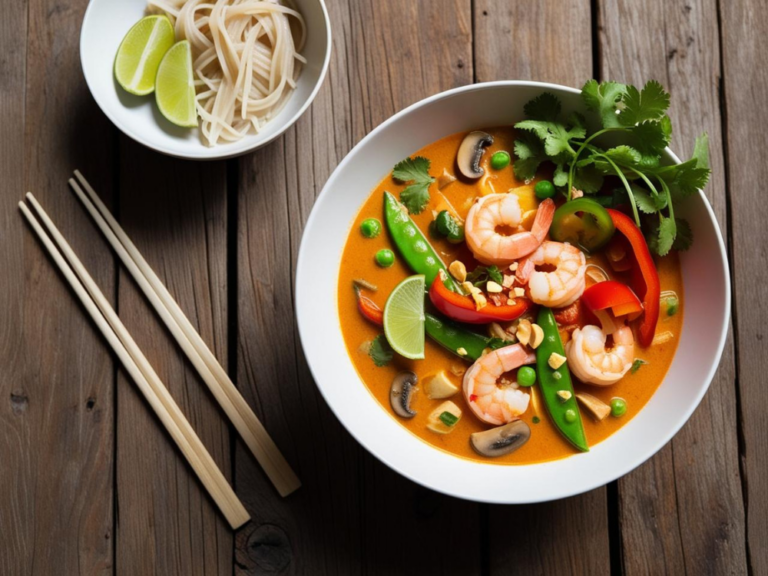
Nutritional Information for Thai Coconut Curry Soup with Shrimp
Curious about the nutritional benefits of Thai Coconut Curry Soup with Shrimp? This flavorful and satisfying dish not only delights your taste buds but also provides a range of nutrients to fuel your body. Whether you’re watching your calorie intake, looking for a high-protein meal, or aiming to include more veggies in your diet, this soup is a wholesome choice. Let’s break down the nutrition facts to help you understand exactly what you’re getting in each delicious bowl.
Calories and Serving Size
A typical serving of Thai Coconut Curry Soup with Shrimp contains approximately 300–400 calories. The exact calorie count depends on factors like portion size, the amount of coconut milk used, and whether you include rice noodles. This makes it a fantastic option for those looking for a meal that’s both satisfying and calorie-conscious.
Macronutrients Breakdown
Here’s a closer look at the macronutrient content of the soup, based on one serving (about 2 cups):
- Protein: ~20–25 grams
- The shrimp is the primary source of protein in this dish, offering a lean and low-fat option to help repair muscles and keep you full.
- Carbohydrates: ~15–20 grams
- The carbohydrates mainly come from vegetables and optional rice noodles. This is a moderate amount, making the soup suitable for low-carb diets if the noodles are omitted.
- Fats: ~20 grams
- The creamy coconut milk contributes healthy fats, which provide lasting energy and help absorb fat-soluble vitamins. Most of the fats are medium-chain triglycerides (MCTs), known for their potential metabolic benefits.
Key Vitamins and Minerals
This soup is packed with micronutrients, thanks to its mix of shrimp, vegetables, and aromatic spices. Here are some of the standout vitamins and minerals:
- Vitamin C:
- Found in lime juice and red bell peppers, vitamin C supports your immune system, promotes healthy skin, and helps your body absorb iron.
- Vitamin A:
- Red curry paste and bell peppers provide beta-carotene, which converts to vitamin A in your body. This is essential for eye health and a strong immune system.
- Potassium:
- Coconut milk and vegetables like snap peas are great sources of potassium, which helps regulate blood pressure and maintain electrolyte balance.
- Selenium:
- Shrimp is rich in selenium, a powerful antioxidant that helps protect cells from damage and supports thyroid health.
- Iron:
- The shrimp and vegetables in the soup contribute iron, which is important for energy production and oxygen transport in the blood.
Dietary Fiber
With a mix of snap peas, mushrooms, and red bell peppers, Thai Coconut Curry Soup with Shrimp contains about 3–5 grams of dietary fiber per serving. Fiber supports digestive health, keeps you feeling full, and helps stabilize blood sugar levels.
Low in Sugars
This soup is naturally low in sugars, with most of the sweetness coming from the coconut milk and a small amount of brown sugar used to balance the flavors. For those watching their sugar intake, this dish is a smart choice.
Sodium Content
One thing to keep in mind is the sodium level, which can range from 700–1,000 mg per serving, depending on how much fish sauce and curry paste you use. While these ingredients add essential flavor, you can reduce the sodium by:
- Using a low-sodium broth.
- Cutting back on fish sauce and adding a squeeze of lime for flavor balance.
Customizing for Specific Diets
One of the best things about this soup is how easily it can be adjusted to fit various dietary needs:
- For Keto or Low-Carb Diets: Skip the rice noodles and load up on extra shrimp and vegetables to keep the carbs low.
- For Paleo Diets: Ensure the curry paste and fish sauce are paleo-friendly, and you’re good to go!
- For Gluten-Free Diets: Use gluten-free fish sauce and double-check your curry paste for hidden gluten.
- For Vegan Diets: Swap shrimp for tofu or chickpeas, and use vegetable broth instead of chicken broth.
Why This Matters
Understanding the nutritional profile of Thai Coconut Curry Soup with Shrimp isn’t just about counting calories—it’s about appreciating how this dish fuels your body with wholesome, nutrient-dense ingredients. Whether you’re prioritizing protein for muscle recovery, healthy fats for energy, or vitamins to boost your immune system, this soup delivers it all in one flavorful bowl.
Final Thoughts on Nutrition
Thai Coconut Curry Soup with Shrimp is proof that healthy eating doesn’t have to be boring. With its creamy texture, vibrant veggies, and zesty flavors, it’s a meal that satisfies your cravings while supporting your wellness goals. Whether you’re cooking for yourself, your family, or entertaining guests, this soup is a nourishing choice that you can feel great about serving.
So, the next time you’re looking for a dish that’s as nutritious as it is delicious, turn to this recipe. It’s a complete package—big on flavor, low on guilt, and perfect for anyone who loves a comforting, wholesome meal!
Try some of our other recipes!
The History and Cultural Background of Thai Coconut Curry Soup with Shrimp
Thai cuisine is beloved worldwide for its vibrant flavors, aromatic spices, and perfect balance of sweet, sour, salty, and spicy elements. Thai Coconut Curry Soup with Shrimp is no exception—this dish embodies everything that makes Thai food special. But where does this comforting bowl of curry soup come from? To truly appreciate its depth and complexity, let’s explore its history and cultural significance.
The Origins of Thai Curry
Curries are an essential part of Thai cuisine, with their origins deeply rooted in the country’s rich culinary history. The word “curry” itself is believed to have been derived from the Tamil word “kari,” meaning sauce, but Thailand’s interpretation of curry is uniquely its own. While Indian and Thai curries share some similarities, Thai curries are distinct in their use of fresh herbs, chilies, and coconut milk, creating a lighter, brighter, and more aromatic flavor profile.
The introduction of chilies to Thailand is credited to Portuguese traders in the 16th century, and over time, these became a staple in Thai cooking. Combined with traditional Southeast Asian ingredients like lemongrass, galangal, and kaffir lime leaves, Thai curry evolved into a dish that showcases the country’s abundant tropical produce and complex flavor traditions.
Coconut Milk: A Staple in Thai Cooking
Coconut milk is a cornerstone of Thai cuisine, particularly in the central and southern regions of the country where coconut trees are plentiful. It adds creaminess and richness to dishes while mellowing out the heat from spicy chilies. In Thai Coconut Curry Soup with Shrimp, coconut milk plays a vital role in balancing the bold flavors of the curry paste and creating the soup’s signature silky texture.
Coconut milk has been used in Thai cooking for centuries, not just for its flavor but also for its ability to preserve food in tropical climates. Its versatility has made it a key ingredient in a wide range of Thai dishes, from curries to desserts like mango sticky rice.
Shrimp: A Connection to Thailand’s Coastal Culture
Thailand’s geography, with its long coastline and numerous rivers, has made seafood a central part of the country’s diet. Shrimp, in particular, is a favorite ingredient in Thai cooking due to its accessibility and versatility. Fresh shrimp is often used in soups, curries, and stir-fries, lending a sweet, briny flavor that pairs beautifully with Thailand’s bold spices and herbs.
In Thai Coconut Curry Soup with Shrimp, the inclusion of shrimp reflects the coastal heritage of Thai cuisine. It’s a nod to the country’s fishing communities, where fresh seafood is a way of life and a source of pride.
Regional Influences on Thai Coconut Curry Soup
Thai cuisine is incredibly diverse, with each region contributing its unique flavors and techniques. Thai Coconut Curry Soup with Shrimp is most closely associated with the central and southern regions of Thailand, where coconut-based curries are especially popular.
- Central Thailand: Known for its balanced flavors, central Thai cuisine often combines sweet, sour, salty, and spicy elements. Coconut milk is a staple here, and red curry paste is commonly used to create flavorful soups and curries.
- Southern Thailand: This region is known for its bold and spicy dishes, often featuring an abundance of seafood due to its proximity to the Gulf of Thailand and the Andaman Sea. Southern Thai curries tend to be richer and spicier, often using fresh turmeric and other local spices.
Cultural Significance of Thai Soups
Soups hold a special place in Thai meals and are typically served alongside other dishes as part of a communal dining experience. Unlike Western meals, where soup might be a starter or a standalone course, Thai soups are often enjoyed simultaneously with rice, curries, stir-fries, and salads. This approach highlights the Thai philosophy of creating a harmonious balance of flavors and textures in every meal.
Thai Coconut Curry Soup with Shrimp embodies this philosophy. Its creamy, aromatic broth complements the fresh, slightly sweet flavor of the shrimp, while the vegetables add crunch and color. It’s a dish that brings together the best of Thai cooking in one comforting bowl.
Modern Adaptations and Global Appeal
While deeply rooted in Thai culinary traditions, Thai Coconut Curry Soup with Shrimp has gained global popularity thanks to its accessibility and adaptability. It’s a dish that can be easily tailored to suit different tastes and dietary preferences, making it a favorite in home kitchens and restaurants worldwide.
The global appeal of this soup reflects the growing appreciation for Thai cuisine, which has become one of the most beloved and recognized cuisines internationally. Thai food’s emphasis on fresh, high-quality ingredients and bold flavors makes it a natural fit for modern food trends focused on health and sustainability.
A Dish That Tells a Story
When you enjoy a bowl of Thai Coconut Curry Soup with Shrimp, you’re not just savoring a delicious meal—you’re also experiencing a piece of Thai culture and history. From the use of locally sourced ingredients like coconut milk and shrimp to the careful balance of flavors that defines Thai cooking, this soup is a testament to the country’s rich culinary heritage.
Whether you’re preparing this dish at home or ordering it at a restaurant, knowing the story behind Thai Coconut Curry Soup with Shrimp adds a deeper appreciation for its flavors and cultural significance. It’s more than just a soup—it’s a flavorful journey into the heart of Thailand. So next time you take a spoonful, remember that you’re tasting centuries of culinary tradition in every bite!
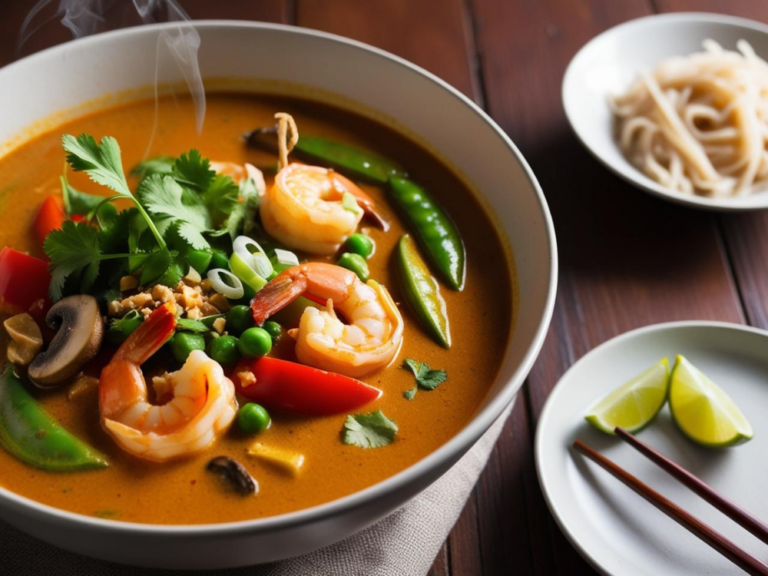
Perfect Pairing Suggestions for Thai Coconut Curry Soup with Shrimp
Thai Coconut Curry Soup with Shrimp is a show-stopper on its own, but pairing it with the right side dishes and beverages can elevate your meal into an unforgettable dining experience. Whether you’re hosting a Thai-inspired dinner party or enjoying a cozy night in, these pairing suggestions will complement the soup’s creamy, spicy, and tangy flavors perfectly. Let’s explore some delicious ideas!
1. Steamed Jasmine Rice or Sticky Rice
No Thai meal is complete without rice, and Thai Coconut Curry Soup with Shrimp is no exception. Steamed jasmine rice is the perfect companion, as its delicate aroma and fluffy texture absorb the rich curry broth beautifully. If you’re in the mood for something heartier, opt for sticky rice, which adds a slightly chewy contrast and pairs wonderfully with the soup’s bold flavors.
Tip: Serve the rice on the side or add a scoop directly to your bowl of soup for a more filling meal.
2. Fresh Spring Rolls (Gỏi Cuốn)
Light and refreshing, fresh spring rolls are an excellent appetizer to serve alongside your soup. These rolls, filled with crisp veggies, herbs, and shrimp or tofu, offer a cooling balance to the warm and spicy curry. Serve them with a tangy peanut dipping sauce or a light hoisin-based dip to enhance the flavor contrast.
3. Thai Papaya Salad (Som Tam)
For a zesty and crunchy side dish, try Thai papaya salad. Made with shredded green papaya, lime juice, fish sauce, garlic, and chilies, this salad provides a tangy and spicy kick that complements the creamy richness of the curry soup. The refreshing crunch of the papaya adds a lovely textural contrast to the meal.
4. Crispy Thai Fish Cakes (Tod Mun Pla)
If you’re looking for something savory and satisfying, crispy Thai fish cakes are a fantastic choice. Their bold flavors, thanks to the addition of red curry paste and kaffir lime leaves, mirror the aromatic spices in the soup. Serve with a sweet chili dipping sauce for an irresistible combination.
5. Noodles
While the soup can stand alone as a light meal, adding a side of noodles—or incorporating them directly into the soup—can make it heartier. Rice noodles or egg noodles work best, as they soak up the curry broth beautifully without overpowering the delicate shrimp.
6. Thai Cucumber Salad
A light cucumber salad dressed with rice vinegar, sugar, and a touch of chili is another refreshing pairing option. The crisp, cool cucumbers and sweet-tangy dressing balance the spiciness of the curry soup, providing a palate-cleansing side dish.
7. Thai-Style Flatbread or Roti
For an unexpected twist, serve the soup with Thai-style flatbread or roti. The flaky, buttery bread is perfect for dipping into the creamy curry broth, making every bite extra indulgent. This pairing is especially popular in southern Thai cuisine and adds a comforting touch to the meal.
8. Beverages to Complement the Soup
- Thai Iced Tea: This sweet and creamy tea, made with black tea, spices, and condensed milk, is the perfect way to cool your palate between bites of spicy soup.
- Coconut Water: For a lighter option, coconut water’s natural sweetness and refreshing qualities make it a great choice to accompany the rich flavors of the curry.
- Sparkling Water with Lime: Keep things simple with sparkling water and a squeeze of lime to cleanse your palate and enhance the soup’s zesty notes.
- Beer: A cold, light beer like Singha or a wheat beer complements the bold and spicy flavors of the soup without overpowering them.
9. Desserts to End the Meal
No meal is complete without a sweet treat to round things out. After enjoying Thai Coconut Curry Soup with Shrimp, opt for a dessert that balances the spice with sweetness and creaminess:
- Mango Sticky Rice: A classic Thai dessert made with sweet sticky rice, ripe mango slices, and a drizzle of coconut cream.
- Thai Coconut Ice Cream: Cool and creamy, this dessert pairs beautifully with the spicy and aromatic flavors of the soup.
- Lychee Sorbet: Light and fruity, lychee sorbet is a refreshing way to cleanse your palate after a flavorful meal.
10. Make It a Full Thai-Inspired Feast
If you’re serving Thai Coconut Curry Soup with Shrimp as part of a larger meal, consider including other iconic Thai dishes to create a complete spread. A few great additions include:
- Pad Thai: A noodle dish with sweet, tangy, and savory flavors to complement the soup.
- Tom Yum Soup: Serve a smaller portion of this tangy, spicy soup alongside your curry for variety.
- Thai Fried Rice: A flavorful and satisfying side that pairs well with the soup’s creamy broth.
Why Pairings Matter
Pairing your Thai Coconut Curry Soup with Shrimp with the right sides, drinks, and desserts enhances the meal’s overall experience. These combinations add variety, balance the flavors, and create a well-rounded dining experience. Plus, offering pairing suggestions in your recipe post adds value for your readers and makes your blog the go-to resource for Thai-inspired meals.
So, the next time you whip up this soup, don’t stop there—try one of these pairings to take your meal to the next level. Your taste buds will thank you!
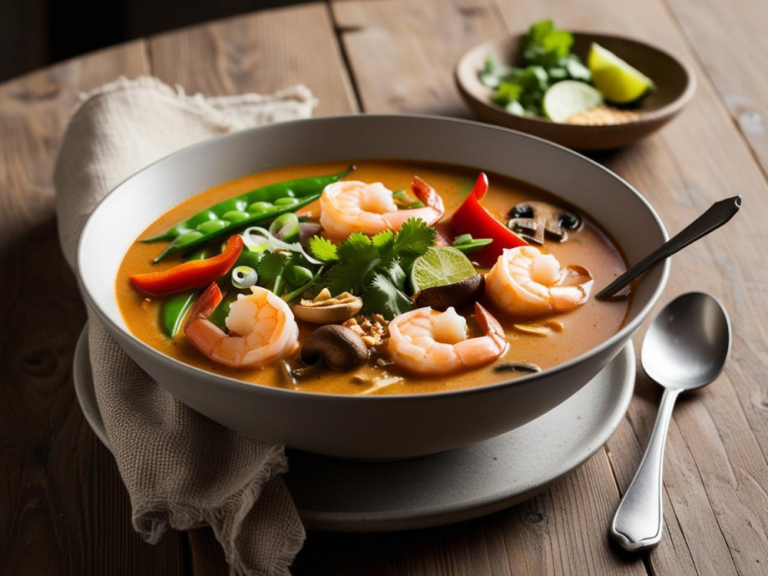
Common Substitutions for Thai Coconut Curry Soup with Shrimp
One of the best things about Thai Coconut Curry Soup with Shrimp is how adaptable it is. Whether you’re working with dietary restrictions, missing an ingredient, or simply looking for a twist, there are plenty of easy substitutions to customize this recipe without compromising on flavor. Let’s dive into some common ingredient swaps that will still give you a bowl of rich, aromatic goodness.
1. Substitutes for Shrimp
If shrimp isn’t an option for you, don’t worry—this soup can shine with a variety of proteins:
- Chicken: Thinly sliced chicken breast or thighs are excellent substitutes. They cook quickly and soak up the curry’s bold flavors beautifully.
- Tofu: For a vegetarian or vegan option, use firm or extra-firm tofu. Cube it and either pan-fry it for a crispy exterior or add it directly to the soup for a softer texture.
- Fish: White fish like cod, tilapia, or halibut works well. Cut the fish into chunks and simmer gently in the soup until cooked through.
- Scallops or Mussels: For a seafood twist, scallops or mussels make for an elegant alternative to shrimp.
- Chickpeas: If you’re looking for a plant-based protein, canned or cooked chickpeas are a hearty and satisfying addition.
2. Substitutes for Coconut Milk
Coconut milk is a cornerstone of this recipe, but if you’re out of it or need a dairy-free alternative, here’s what you can use:
- Almond Milk with Coconut Extract: Use unsweetened almond milk and add a splash of coconut extract for that signature flavor.
- Cashew Cream: Blend soaked cashews with water to create a creamy, coconut milk-like texture.
- Dairy Milk or Cream: If you’re not avoiding dairy, whole milk or heavy cream can provide a similar richness, though it will lack the coconut flavor.
- Evaporated Milk: This is another non-coconut option that gives the soup a creamy texture.
Pro Tip: If replacing coconut milk, consider adding a teaspoon of sugar to mimic the slight sweetness it brings.
3. Substitutes for Red Curry Paste
Red curry paste is essential for the soup’s bold and spicy flavor, but if you can’t find it or need a quick fix, try these alternatives:
- Green Curry Paste: This will change the flavor slightly, but it works well if you prefer a different type of Thai curry.
- Yellow Curry Paste: A milder option with earthy, slightly sweet notes.
- Sriracha and Curry Powder: Combine a tablespoon of sriracha with a teaspoon of curry powder for a quick homemade alternative.
- Homemade Red Curry Paste: If you’re feeling adventurous, you can make your own using red chilies, garlic, ginger, lemongrass, and spices.
4. Substitutes for Fish Sauce
Fish sauce adds a salty umami punch that’s hard to replicate, but these alternatives come close:
- Soy Sauce: A more common pantry staple, soy sauce provides the salty element but lacks the depth of fish sauce.
- Tamari: A gluten-free option that’s similar to soy sauce in flavor.
- Coconut Aminos: Slightly sweeter and less salty, coconut aminos is a great alternative for those avoiding soy or gluten.
- Miso Paste: Dissolve a small amount of miso paste in the broth to add umami flavor.
Pro Tip: If you skip fish sauce, add a touch of lime juice to balance the flavors.
5. Substitutes for Vegetables
Don’t have the exact veggies on hand? No problem—this soup is flexible when it comes to its vegetable components:
- Snap Peas: Substitute with green beans, broccoli florets, or asparagus.
- Red Bell Peppers: Yellow or orange bell peppers, zucchini, or carrots work just as well.
- Mushrooms: Replace with baby corn, bamboo shoots, or even eggplant for a slightly different texture.
- Spinach: If you don’t have spinach, kale, bok choy, or Swiss chard are excellent alternatives.
6. Substitutes for Broth
The base of the soup relies on chicken or vegetable broth, but you can get creative if needed:
- Water with Bouillon: Dissolve bouillon cubes or paste in hot water for a quick broth replacement.
- Coconut Water: This adds a subtle sweetness and tropical vibe to the soup.
- Homemade Stock: If you have leftover vegetable scraps or shrimp shells, simmer them with water to make a flavorful stock.
7. Substitutes for Lime Juice
Lime juice adds brightness and acidity to balance the richness of the coconut milk. If you’re out of limes, try:
- Lemon Juice: A simple swap that adds a similar tangy flavor.
- Rice Vinegar: A mild, slightly sweet vinegar that works well in Asian dishes.
- Apple Cider Vinegar: Use sparingly to add acidity without overpowering the other flavors.
8. Substitutes for Garnishes
While fresh cilantro, green onions, and lime wedges are traditional garnishes, you can get creative with what you have:
- Parsley: If cilantro isn’t available or not to your taste, parsley offers a fresh herbal touch.
- Basil: Thai basil or even regular basil can add an aromatic flavor.
- Crushed Peanuts or Cashews: These add crunch and richness if you’re out of peanuts.
- Red Chili Flakes or Sriracha: Perfect for adding an extra kick of spice.
Tips for Successful Substitutions
- Taste as You Go: Whenever you swap ingredients, taste the soup frequently to ensure the flavors are balanced.
- Think About Texture: Try to maintain similar textures when substituting vegetables or proteins to keep the dish satisfying.
- Don’t Be Afraid to Experiment: Thai cooking is all about balancing flavors, so have fun and adjust the recipe to suit your preferences!
Why Substitutions Matter
Having substitution options makes Thai Coconut Curry Soup with Shrimp accessible to everyone, no matter their dietary needs, ingredient availability, or cooking preferences. These swaps allow you to put your personal spin on a classic dish while still enjoying the rich, creamy flavors that make it so special.
With these substitution ideas, you’ll never have to worry about missing an ingredient or adapting the soup to suit your needs. Whether you’re cooking for a crowd, experimenting with new flavors, or simply making do with what you have, this soup will always deliver!
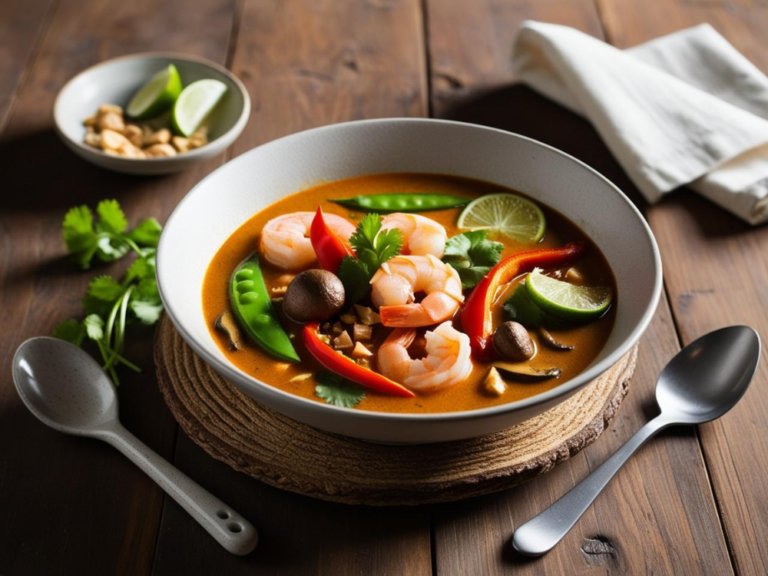
Frequently Asked Questions (FAQs) About Thai Coconut Curry Soup with Shrimp
When it comes to making Thai Coconut Curry Soup with Shrimp, a few common questions always pop up. Whether you’re a first-time cook or a seasoned pro looking for tips, this FAQ section has got you covered. Let’s dive into everything you need to know to make this dish perfect every time.
1. Can I make this soup ahead of time?
Absolutely! This soup is an excellent make-ahead meal. The flavors actually deepen and develop as it sits, making it even more delicious the next day. However, if you’re using shrimp, it’s best to add them fresh when reheating to avoid overcooking. You can prepare the broth and vegetables ahead of time, store them in an airtight container in the fridge, and then cook the shrimp right before serving.
2. Is this soup spicy?
The spice level in Thai Coconut Curry Soup with Shrimp depends on how much red curry paste you use. Traditional red curry paste can be quite spicy, so if you prefer a milder soup, start with one teaspoon and gradually add more to taste. You can also tone down the heat by adding extra coconut milk or serving it with steamed rice.
3. Can I freeze Thai Coconut Curry Soup?
Yes, but with a few tips to ensure the best results. While the broth freezes well, shrimp can become rubbery when thawed, so it’s better to freeze the soup base without the shrimp and add fresh shrimp when reheating. Also, note that coconut milk may separate slightly after freezing. To fix this, whisk the soup well as you reheat it to restore its creamy consistency.
4. What’s the best type of shrimp to use?
For the best flavor and texture, use raw, deveined shrimp with the tails on or off, depending on your preference. Fresh shrimp is ideal, but frozen shrimp works just as well—just make sure to thaw them before cooking. Avoid pre-cooked shrimp, as they can become overcooked and rubbery in the soup.
5. Can I make this soup vegetarian or vegan?
Yes! To make this soup vegetarian or vegan, simply swap the shrimp for tofu, chickpeas, or your favorite vegetables like zucchini or sweet potato. Use vegetable broth instead of chicken broth, and replace fish sauce with soy sauce, tamari, or coconut aminos for a plant-based version that’s just as flavorful.
6. How do I store leftovers?
Store leftover soup in an airtight container in the refrigerator for up to 3 days. When reheating, do so gently over medium heat to preserve the shrimp’s texture and the creamy consistency of the broth. If the soup thickens too much in the fridge, add a splash of broth or coconut milk to loosen it up.
7. What can I serve with this soup?
Thai Coconut Curry Soup with Shrimp pairs beautifully with a variety of sides. Some great options include steamed jasmine rice, sticky rice, or rice noodles for a heartier meal. For a refreshing side, try a Thai cucumber salad or fresh spring rolls. You can also serve it with crispy Thai fish cakes or roti bread for dipping into the creamy broth.
8. Can I use other proteins instead of shrimp?
Definitely! This soup is highly versatile when it comes to proteins. You can substitute shrimp with chicken, tofu, white fish (like cod or halibut), scallops, or even mussels. Just adjust the cooking time to ensure the protein is fully cooked but not overdone.
9. What if I can’t find red curry paste?
If you don’t have red curry paste, you can use green curry paste for a slightly different flavor profile, or yellow curry paste for a milder, earthier taste. In a pinch, mix sriracha and curry powder for a quick homemade alternative. You can also make your own red curry paste from scratch if you have the ingredients, like red chilies, garlic, ginger, and lemongrass.
10. How can I make the soup spicier?
If you love heat, there are several ways to amp up the spice:
- Add extra red curry paste.
- Include sliced Thai bird’s eye chilies during cooking.
- Drizzle sriracha or chili oil on top just before serving.
- Garnish with crushed red chili flakes for an extra kick.
11. Can I use light coconut milk?
While full-fat coconut milk is traditional and provides the richest flavor, you can use light coconut milk for a lower-calorie option. Keep in mind that the soup might be slightly less creamy, but you can balance this by adding a splash of coconut cream or blending some of the soup’s vegetables to thicken the broth.
12. How do I balance the flavors?
Thai cuisine is all about balance, and this soup is no different. If your soup tastes too spicy, add more coconut milk or a touch of brown sugar to mellow it out. If it’s too sweet, add a squeeze of lime juice or a splash of fish sauce. Taste as you go and adjust each element—sweet, sour, salty, and spicy—until it’s just right.
13. How do I ensure the shrimp doesn’t overcook?
Shrimp cooks quickly—usually in just 2–3 minutes. To avoid overcooking, add the shrimp to the soup near the end of the cooking process and simmer gently until they turn pink and opaque. Remove the pot from the heat as soon as the shrimp are cooked to retain their tender texture.
Why an FAQ Section Matters
Having an FAQ section in your recipe post adds tremendous value for your readers. It anticipates their questions, addresses common concerns, and builds confidence in their ability to successfully recreate the dish. By answering these questions, you also make your blog a trusted resource, encouraging readers to return for more helpful, detailed recipes.
With these FAQs, you’re fully equipped to tackle Thai Coconut Curry Soup with Shrimp like a pro. So go ahead, grab your ingredients, and enjoy the magic of Thai cooking!
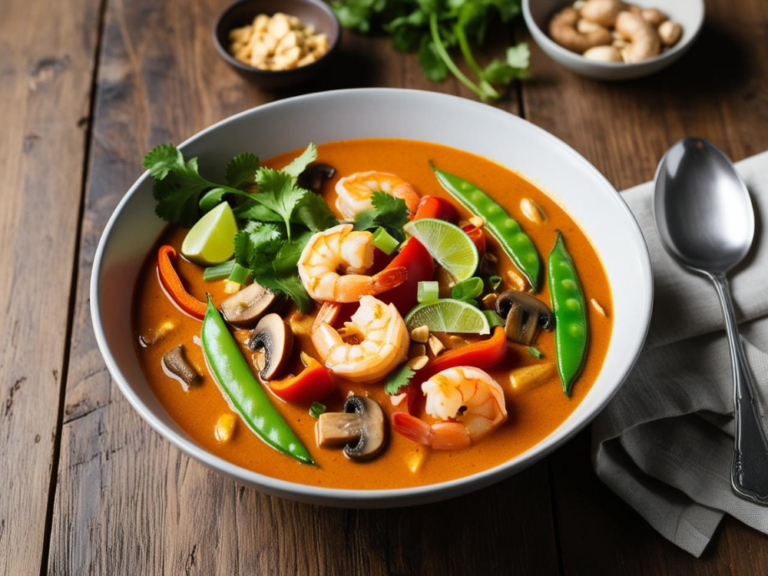
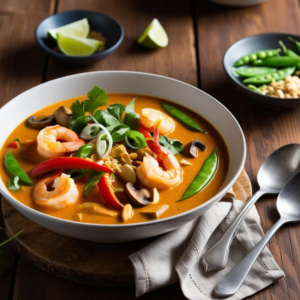
Thai Coconut Curry Soup with Shrimp
Equipment
- Large Pot or Dutch Oven: For cooking the soup.
- Cutting Board: For chopping vegetables and preparing shrimp.
- Sharp Knife: To slice and dice ingredients.
- Measuring Cups and Spoons: For accurate measurements of liquids and spices.
- Wooden Spoon or Ladle: For stirring and serving the soup.
- Small Bowl: To mix or measure ingredients like lime juice or fish sauce.
- Tongs or Slotted Spoon: Useful for handling shrimp or vegetables while cooking.
- Zester or Grater: If you want to add lime zest for extra flavor.
- Colander or Strainer: For rinsing shrimp and vegetables.
- Serving Bowls: For plating the soup.
Ingredients
For the Soup Base
- 1 Tbsp Coconut oil
- 1 Small onion Finely chopped
- 2 Cloves garlic Minced
- 1 Tbsp Fresh ginger Grated
- 3 Tbsp Red curry paste
- 4 Cups Chicken or vegetable broth
- 1 Can 13.5 oz Coconut milk Full fat
- 2 Tbsp Fish sauce
- 1 Tbsp Brown sugar
- 1 Tbap Lime juice Freshly squeezed
For the Soup Additions
- 1 Lb Shrimp Peeled and deveined
- 1 Red bell pepper Thinly sliced
- 1 Cup Mushrooms Sliced
- 1 Cup Snap peas
- 2 Cups Cooked rice noodles (optional)
For Garnish
- Fresh cilantro Chopped
- Green onions Sliced
- Lime wedges
- Crushed peanut or cashews (optional)
Instructions
- Step 1: Prepare the BaseHeat the coconut oil in a large pot over medium heat.Add the onion and sauté until translucent, about 2-3 minutes.Stir in the garlic and ginger, cooking for another minute until fragrant.Add the red curry paste and cook for 1-2 minutes, stirring constantly to release the aromas.
- Step 2: Build the BrothPour in the chicken or vegetable broth, stirring to combine with the curry paste.Add the coconut milk, fish sauce, brown sugar, and lime juice. Stir well and bring the soup to a gentle simmer.
- Step 3: Add the Veggies and ShrimpAdd the bell pepper, mushrooms, and snap peas to the pot. Simmer for 5-7 minutes until the vegetables are tender but still vibrant.Add the shrimp and cook for 3-4 minutes until they turn pink and are fully cooked.
- Step 4: Serve and GarnishIf using rice noodles, place them in individual bowls and ladle the hot soup over them.Garnish with fresh cilantro, green onions, lime wedges, and peanuts or cashews for added crunch.
Notes
Make Ahead
Thai Coconut Curry Soup with Shrimp is a fantastic recipe to prepare ahead of time. Here’s how you can do it:- Prepare the Broth in Advance: Cook the soup base (broth, coconut milk, curry paste, and seasonings) and store it in an airtight container in the refrigerator for up to 3 days.
- Chop Vegetables Ahead: Slice the bell peppers, mushrooms, and other vegetables and store them in separate containers in the fridge.
- Wait to Add Shrimp: Since shrimp cooks quickly, it’s best to add it fresh when reheating the soup to avoid overcooking.
Storage
If you have leftovers, here’s how to store them:-
Refrigeration:
- Transfer the soup to an airtight container and refrigerate for up to 3 days.
- Reheat gently on the stovetop or in the microwave, adding a splash of broth or coconut milk if the soup has thickened.
-
Freezing:
- The soup base (without the shrimp) freezes well. Store it in a freezer-safe container or zip-top bag for up to 3 months.
- When reheating, thaw the base in the refrigerator overnight, then reheat on the stovetop and add fresh shrimp and vegetables.

Bring the Flavors of Thailand to Your Table
There’s something truly special about a dish like Thai Coconut Curry Soup with Shrimp. It’s warm, comforting, and packed with vibrant flavors that feel like a culinary escape. Whether you’re making it for a quick weeknight dinner, prepping it ahead for a busy week, or serving it to impress friends and family, this recipe has all the right elements to bring joy to your table.
The combination of creamy coconut milk, tender shrimp, fresh vegetables, and aromatic spices makes every spoonful feel like a celebration of Thai cuisine. And the best part? It’s versatile enough to customize for your tastes or dietary needs.
So grab your ingredients, take a little time to cook, and enjoy a meal that’s more than just food—it’s an experience. Don’t forget to share your creations, experiment with new pairings, and make this recipe your own. Happy cooking!
Join Now!
Love this recipe? Don’t miss out on even more delicious, healthy, and easy-to-make recipes like this Thai Coconut Curry Soup with Shrimp! By joining our email community, you’ll gain access to exclusive content, bonus recipes, and tips to make clean eating a breeze.
Enter your email & click below to subscribe and start receiving tasty inspiration right away. It only takes a minute to join our growing community of food lovers dedicated to making healthy eating delicious and fun.

